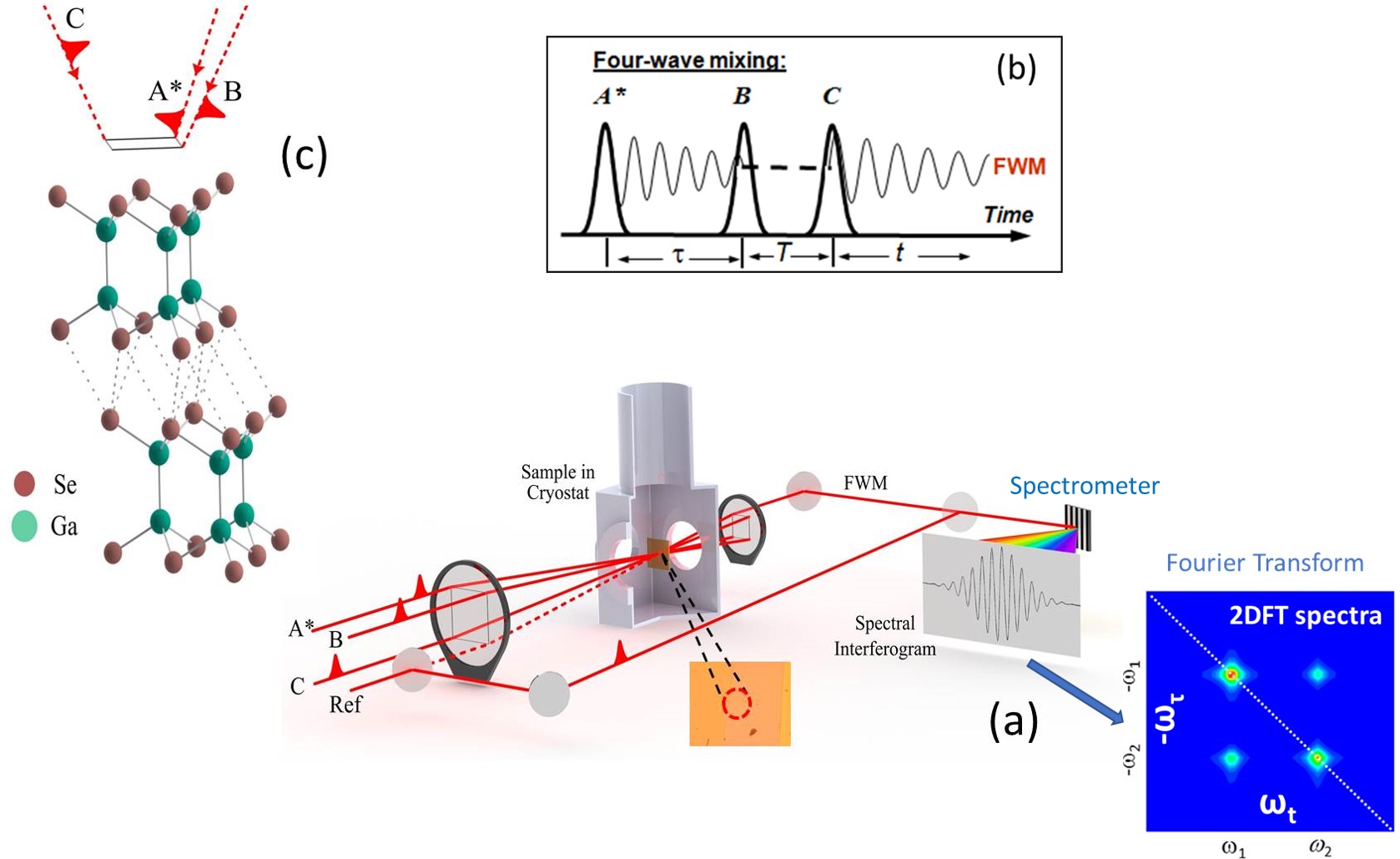Current Research
- Time-Resolved and Nonlinear Two-Dimensional Spectroscopy
- Two-Dimensional Spectroscopy at extreme Magnetic Fields
- Magneto-Optic Kerr Effect
- Silicon based Atomic Clock
- Materials of Interest
Time-resolved and nonlinear two-dimensional Fourier transform (2DFT) spectroscopy

The ultrafast lasers are used to perform time-resolved experiments including coherent four-wave mixing and 2DFT experiments on a variety of materials. Each of these techniques provides specific information on the many-body dynamics. Multidimensional Fourier transform spectroscopy monitors different time delays simultaneously and explicitly tracks the phase of an induced nonlinear signal generated by the sequence of excitation pulses. Tracking the phase with respect to the time delays between excitation pulses results in a time-domain data set, which is converted to 2DFT spectrum with a Fourier transform. The advantages of this technique over conventional techniques are well documented in the literature. The closest analogy would be the extension of nuclear magnetic resonance from one to two dimensions.

Figure (a) shows The four phase-stabilized beams obtained from the multi-dimensional optical nonlinear spectrometer (MONSTR) instrument are focused on the sample, which is held in the cryo-stat at 5 K. A portion of the laser pulse has been split off and co-linearly recombined with the FWM signal for heterodyne detection. The combined beams are dispersed in the spectrometer resulting in the spectral interferogram. (b) The sequence of the laser pulses used in the experiments, where A∗ corresponds to the phase conjugated pulse. (c) Crystal structure of the Layered material GaSe representative of materials we study. For a detailed description of the instrument see: Dey et. al., Rev. Sci. Instrum. 84, 023107 (2013).
Our capability in performing 2DFT experiments is based on the MONSTR apparatus developed recently, which is continuously tunable between 520 nm to 1100 nm without changing any optics or performing alignement of the internal components. The apparatus is an ultrastable platform consisting of nested and folded Michelson interferometers that can be actively phase stabilized. The output pulses for nonlinear excitation of materials are arranged in the ‘box’ geometry with phase-stabilized reference pulses for heterodyne detection of the induced signal. The transient four-wave mixing (FWM) signal is a result of the third order polarization of the material P(3)(t) = χ(3)E3(t) where the third order susceptibility χ(3) defines the third order response and is determined by the intrinsic properties of the material. In a three pulse FWM experiment three short laser pulses excite the sample separated by two time intervals τ and T. The laser pulses are aligned in the ‘box’ geometry where the FWM signal propagates along the fourth corner of the square, in one of the phase matching direction -k1+k2+k3. In 2DFT spectroscopy, the nonlinear FWM signal is recorded as a function of the time delay between the excitation pulses and heterodyne detected with the reference pulse.

Photograph of the MONSTR and external optics using the 488.5 nm laser for active phase stabilization and providing four orange beams at 593 nm for the 2DFT experiment.
The main ideas of this technique were inspired by the work in 2D NMR. The heterodyne detection (combining the signal with a reference pulse) and preserving the phase information through phase-stabilization allow us to record the whole phase evolution. Correlating the phases enables coupling between transitions to be determined, which makes this technique particularly suited for strongly correlated systems since it has the potential to disentangle such couplings. The resulting two-dimensional spectra are obtained from a Fourier transform with respect to two time delays, either τ and T, or t and T. The 2DFT spectroscopy can resolve, separate, and isolate many-body contributions to the light-matter interactions associated with electronic excitation at optical frequencies.